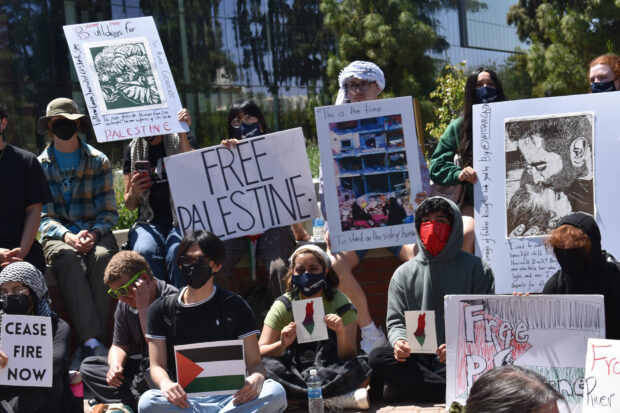
The Women’s International League for Peace and Freedom (WILPF) is an activist, grassroots, social justice organization founded to stop wars. Current campus protests against the war on Palestinians are aligned with positions that WILPF has taken and continues to press for.
How are the thousands of campus protesters, mostly students, organizing against Israel’s war on Palestine and what forms of resistance do they face? What can we learn from them, and how can we help them?
Campus Protests
Given the dearth of journalistic coverage, it is impossible to count the number of higher-education campuses on which protests have been staged. There were at least 140 as of May 6. By May 16, more than 2,950 students, faculty and staff had been arrested on 66 campuses.
Student strategies vary and are creative. They have staged sit-ins, die-ins, marches, rallies, hunger strikes, occupations and graduation disruptions.
Students have made at least 120 encampments. Some were quickly removed by police. Some have lasted weeks and range in size from six to 100 tents.
Most universities have had the encampments removed. However, at Wesleyan University in Connecticut, professors have taught classes among the tents, and UC Berkeley has not threatened its students’ tent city. When officials at the New School in New York City took down its indoor student encampment, faculty established their own.
During this spring’s graduation ceremonies, students have subverted the usual order, turning their backs on speakers and walking out chanting “Free, Free Palestine.”
On some campuses, faculty have stood protectively between students and police, like Annelise Orleck, the 65-year-old Dartmouth College feminist labor historian and former head of Jewish studies, whom the police dragged to the ground.
University and Police Responses
Beyond the 2,900-plus arrests, university officials have expelled students from classes and campus residences. They have attacked demonstrators and torn down encampments. They have beaten and tear-gassed students and closed campuses.
Several universities have canceled, postponed or reengineered graduations, and canceled speeches, such as South Asian Muslim Asna Tabassum’s valedictory speech at the University of Southern California.
Many schools have sent in police. At UCLA, city police watched (and filmed) for hours as 100 pro-Israeli counter-protesters disassembled the student encampment, kicked and punched protesters, and used strobe lights, firecrackers, sound blasts, bricks, pepper spray, wooden planks and metal poles on them, leading to 25 hospitalizations.
Elsewhere, police have used rubber bullets and tear gas and “skunk,” a chemical munition developed in Israel. At Arizona State University, police officials have been charged with attacking and removing the hijabs of four Palestinian students.
For context, it is important to know that several states have passed new laws protecting police from any meaningful community oversight, making police into “super citizens” with rights and immunities other residents don’t have. In addition, both public access and press coverage are being restricted.

When Columbia University brought in police to end the occupation of Hamilton Hall and arrested more than 100, it prohibited press and the public from entering campus. And most of the press coverage is filtered through a bias that favors the state of Israel.
Though UCLA holds the arrest record, it is significant that some of the most ferocious attacks were ordered at elite universities with multibillion-dollar endowments, such as Columbia, Penn and Dartmouth, where many investments are connected to war profiteering.
National legislators are calling for protesters to be sent to Gaza and for international student protesters to be deported. They are threatening to remove federal funding from schools where students are allowed to protest the actions of the state of Israel, labeling these protests “antisemitism.”*
In another official rhetorical strategy used to delegitimize protesters and infantilize students, New York City Mayor Eric Adams, a former cop, likes to label the protesters “outside agitators,” a trope familiar to 1960s antiracist and antiwar protesters. The label suggests that non-student participants are suspect and should not be on campus. It suggests students couldn’t possibly develop their understandings, beliefs and strategies themselves.
Student Demands
The wide range of student demands reveals deep learning about political economy and university processes. In addition to calling for their respective universities to support a permanent ceasefire, students are demanding meetings with administrators to achieve the following:
- Divest from weapons manufacturing companies and others profiting from Israel’s occupation of Gaza
- Remove war profiteers from our universities
- Engage in financial transparency
- Accept no funding from Zionist organizations that stifle students’ free speech
- Create police community review boards
- Create an alternative model of crisis response
- Prohibit study-abroad programs to Israel, Gaza or the West Bank until Palestinian students can be admitted
- Admit students from Gaza to U.S. universities
- Support the International Criminal Court’s call for further investigation of Israel’s actions in the war
- Divest from all sites of settler colonialism
- End relationships and exchanges with Israeli universities and institutes, for example, Tel Aviv University, which designs weapons systems and holds the corpses of 60 Palestinians
- Guarantee free expression on campus
- Provide amnesty for students barred, expelled and arrested
- Create Middle East studies programs and Arab cultural centers
- Allow Palestinian flags on campus
- Acknowledge Palestinian students, specifically
- Hire Palestinian professors
- Remove all cops from campus indefinitely
- End “Palestine exceptionalism” limits on free speech
Student Successes
There is no one tactic that is successful and context matters.
Students are strategizing for effectiveness and safety. As they plan actions, they hold discussions of how much risk each is willing to take, given that many students have been suspended, kicked out of campus housing and/or arrested.
Many Palestinian students are organizing in ways to minimize danger for themselves and their families, some of whom live in Palestine. For example, they choose not to use their surnames. To prevent administrative interventions and attacks by observers, some choose not to have speakers, but to hold quiet sit-ins where some leaders speak to the press.
With respect to divestment, a universal demand, some student groups have achieved guarantees of negotiations with boards of directors, usually in the fall. A handful of schools have already agreed to divest. A few universities have also agreed to financial transparency.
Successful negotiations have featured officials revoking student expulsions and desisting from legal prosecutions when students remove their encampments.
The greatest success is the knowledge acquired actively protesting, for example, learning how universities actually work in contrast to their polished published statements.
Students experience power laid bare. They acquire hands-on political awareness, local and global. They learn to be organizers, with all the creativity they can muster. They learn to work together toward peace and social justice goals.
Confronting power as they are brings lifelong transformations in thinking and action. We are watching future WILPFers.
How to Be Allies
Many WILPFers are already involved. For those who are not connected to a campus already, some further suggestions are to exchange contact information with student activists and respond to their requests for physical, psychological, legal and other needs. Record their actions and share videos with other activists and with the media. Write and speak about what you see.
*The Anti-Semitism Awareness Act, which easily passed the U.S. House of Representatives, contains a many-faceted definition of antisemitism, which lists, as an example pertinent to the current situation, “Drawing comparisons of contemporary Israeli policy to that of the Nazis.” This definition relies on and is quoted from the International Holocaust Remembrance Alliance’s “Working definition of antisemitism” (2016). More than 700 Jewish professors have signed a letter rejecting this definition.
